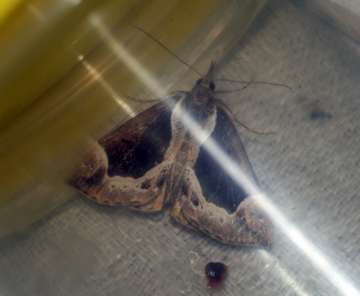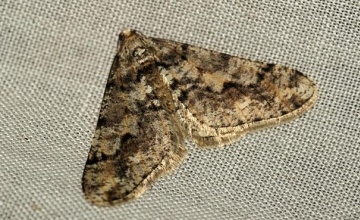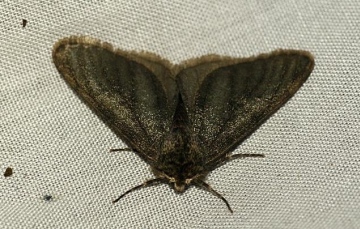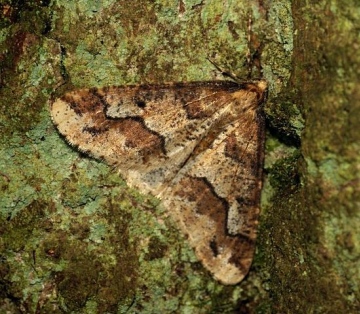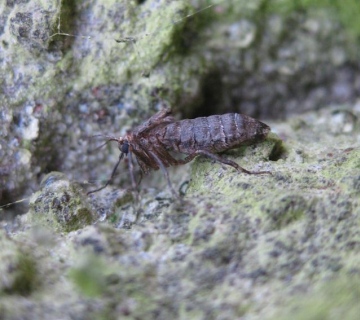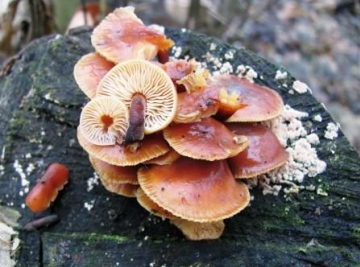Your Forum
The weblog below is for naturalists to use to report interesting sightings, ask questions, report on field meetings and generally post pictures and any information or questions generally relevant in some way to the wildlife and geology of Essex. You will need to register and be logged-on to post to the forum, and you need to upload pictures first, for use in posts. Find out more
|
Thu 27th January 2011 22:35 by Ben Sale
Great to see the recorders names come up on the dots now! thats brilliant. Thu 27th January 2011 19:55 by Ben Sale
Hi Peter
My mistake it was back in 2009! where does the time go. The date is 21/07/09 at Thorndon Country Park Grid ref : TQ605913 Regards Ben Thu 27th January 2011 18:53 by Peter Harvey Psoricoptera gibbosella
Hi Ben, I can't find the record in the spreadsheet you sent me.
Have you got a specific date and better than tetrad grid reference please. Thu 27th January 2011 17:57 by Graham Smith Nature Red in Tooth & Claw - almost
Blue House Farm EWT Reserve, January 26th : 2000 Lapwing rose as one from Round Marsh and departed for the surrounding fields. An adult female Peregrine appeared. A single Lapwing (the only one remaining) took flight and was immediately attacked by the falcon. It dodged a dozen or more short stoops by the Pergrine, swerving to left or right an instant before impact, the two birds weaving an erratic pattern across the sky. A second Peregrine arrived on the scene, this time an adult male. He and his mate attacked the Lapwing in tandem; an unfair contest. He won the prize but the weight of the Lapwing dragged him down, predator and prey spiralling slowly earthwards. As they hit the ground he lost his grip and the Lapwing bounced free and took flight. The female Peregrine resumed the assault. Her would-be dinner crash landed in the deep water channel that crosses the marsh, then dived. The falcon hovered above the water, lunging at the Lapwing each time it was forced back to the surface to breathe. Three, four, five, six times she snatched at its head but on each occasion it eluded here and re-dived. Then she gave up and retreated to a fence post to preen. The Lapwing continued 'downstream', still repeatedly diving, emerging from the water after fifty yards or so and seeking sanctuary among the rushes. Initially I thought that the Lapwing must be poorly (or dimwitted) to remain on the marsh when all its companions had departed but, ill or not, its performance demonstrated an extraordinary will to survive and I saluted it.
A friend once told me of a similar incident that took place while he was sailing his dinghy in the Blackwater. On this occasion the assailant was again a Peregrine, its intended victim another wader, a Turnstone. The latter was obviously physically spent and on the point of being killed when it saw his boat and changed direction towards it. It arrived just ahead of the Peregrine and dived into the water, resurfacing beneath the prow of his boat, where it hid, treading water. Frustrated, the falcon circled low overhead, hoping the Turnstone would panic and resume flight, but after a few minutes gave up and flew off. Shortly afterwards the Turnstone emerged from its hiding place and headed off in the opposite direction. On another occasion, friends watched a Redshank being pursued by two Peregrines, a Merlin and a Marsh Harrier at Mayland. Remarkably, the Redshank eluded all four of them, again by diving into the water, re-emerging after a few yards, flying a short distance and then repeating the procedure. Even so, it is unlikely that it would have survived had not the superabundance of raptors pursuing it decided to bicker among themselves, giving it time to make for the cover of the saltings. Waders have evolved to wade, not to dive underwater (although most can swim tolerably well when feeding in the shallows) but it would appear that new tricks can soon be learned when it comes to the survival of the fittest! Thu 27th January 2011 17:10 by Ben Sale Psoricoptera gibbosella
Hello Peter, adding pictures I noticed that the micro-moth Psoricoptera gibbosella is not on the map
The record is from Thorndon Country Park - 2010 Grid Ref - TQ69A Thought i'd mention it as it is quite a good record. Regards Ben Mon 24th January 2011 17:30 by Graham Smith More stressful tales
Thanks Mary. Most of the trees affected at Fryerning were (or are) situated alongside paths, either tarmaced (as in the old churchyard) or of hard stony ground and the soil around them is further compacted by the trampling of many feet. I seem to recall from one of the 'A Year at Kew' TV programmes that they have a similar problem there and have to regularly loosen the soil around the trees to allow rain to reach the roots. Perhaps that is part of the problem in the churchyard. I will have to get digging!
While we are on the subject of stressed out naturalists, I completed one of my regular BTO 'Bird Track' surveys at Margaretting today and in fifty years of walking the farmland in this area I cannot recall a more dispiriting count. Pigeons, Corvids and Gulls apart, three hours of walking produced 30 birds of 11 species and not a single farmland (as opposed to woodland edge) species among them! I have never spent three hours in the Essex countryside before without seeing a Chaffinch! Then, at the very end of the walk, a Red Kite flew overhead, a bird still scarce enough in Essex to lift my spirits. Alas, how easily we are sidetracked by the rare and the exciting. Even so, it was a relief to get back to suburbia and a garden full of birds. For the record, since the 1939-45 War (but mostly in the past 25 years) fourteen species have, for various reasons (most often habitat loss or deterioation) been lost as breeding birds from Ingatestone parish, namely, Grey Partridge, Lapwing, Redshank, Snipe, Nightjar, Red-backed Shrike, Tree Pipit, Yellow Wagtail, Willow Tit, Nightingale, Hawfinch, Lesser Redpoll. Corn Bunting and Tree Sparrow. A further seven - Barn Owl, Kingfisher, Skylark, Mistle Thrush, Garden Warbler, Bullfinch and Reed Bunting - have declined by 80+% and eleven - Turtle Dove, Cuckoo, Spotted Flycatcher, Lesser Spotted Woodpecker, House Martin, Marsh Tit, Song Thrush, Willow Warbler, Linnet, Yellowhammer and House Sparrow - by between 90 and 99 per cent! Still, it could be worse. I'm sure they're working on it ---------!!! I'm off to have a stiff drink! Graham Sun 23rd January 2011 07:36 by Mary Smith Trees at Fryerning
Yes, Graham, I agree that the trees must be rather stressed (like everything else, as you said, including us) as otherwise fungi would not be able to get such a big hold. And maybe non-native trees are more prone to attack by fungi anyway, or more prone to stress, or both, but I don't know. But the cause of stress cannot really be drought with the damp summer we have had, surely? Maybe it was last winter's cold, but i don't know. I still think that the way forward is to allow new trees to grow. And I am not saying planting new ones, as I would suggest they are probably more likely to succumb than big old well-established ones, do you think? Sat 22nd January 2011 17:55 by Graham Smith Fryerning Churchyard
Mary, I certainly agree that the loss of trees at Fryerning is a natural occurrence but to lose so many trees in a short space of time makes you wonder whether many of them are suffering stress from summer droughts and other factors. It would also be interesting to know if there is any evidence of an increase in such stress related losses in the wider countryside. After all, much else is stressed out there nowadays, birds, bees and natural historians among them! As for Waxwings, you should have a few weeks yet to see them. Graham Sat 22nd January 2011 17:41 by Mary Smith Waxwings and fungi
Waxwings!! I keep being told how many there are this winter, and I go for walks around my home almost every day but I haven't seen a single one! Now they are at Lakeside retail park, which is a bit far for me to walk or cycle, but possible nearer than Ingatestone. I am told they like gardens with berries on bushes, especially Cotoneasters, which other birds seem not to like as they are always left till last. How long have I got to see a waxwing? When do they depart these shores?
As for the fungi in Fryerning churchyard killing the trees, this is all part of the cycle of nature and is best left alone. Trees get killed! That is what some fungi are meant to do! Lots of other fungi assist the growth of living trees and other plants, so it is only a few we don't like. But I think the problem, insofar as it is a problem, is more like the lack of new saplings to take the place of the dying ones. If nobody mowed the grass, other trees would readily grow! If the existing trees drop fertile seeds (I think some of these foreigners would not, but most would), then they will be making saplings. Down with the lawnmower if you want more trees! Sat 22nd January 2011 17:19 by Graham Smith Second Happy Bunny
Blue House Farm EWT Reserve, North Fambridge : Now that birds have returned to the reserve in large numbers, following the freeze, their predators too are becoming more obvious. In the past week there have been sightings of 3 Sparrowhawks (one flushed from the remains of a Dunlin), a pair of Marsh Harriers, 2 Hen Harriers (including a superb adult male), 3 Buzzards, 2 Peregrine (one of which was seen to catch a Grey Plover), 3 Merlin and 2 Barn Owl, the last of which counts as a honorary raptor for the purpose of this note! Best of all though was a Rough-legged Buzzard. It flew in off the Fambridge-Althorne ridge and after being beaten up by a female Marsh harrier landed in a large bush directly opposite the BWA hide, where it remained for around forty minutes. This caused a few bunny hops by the occupant of the hide, namely, me! The Rough-leg is a scarce winter visitor from northern Scandinavia and the Arctic, where its numbers are largely governed by the abundance or otherwise of its principal prey, Lemmings. The latter's population is cyclical, numbers building to a peak every few years or so, then crashing. When they are high the buzzards often succeed in rearing four or five young, when low they often fail to rear any at all. Should Lemmings remain plentiful for two or three years then the number of young buzzards can exceed the food supply on their wintering grounds and many are forced to migrate further south, occasionally arriving in Britain in large numbers. Even in poor years a few reach our shores and at least one has been reported from various parts of North Essex during the past couple of months. I was hoping I might bump into it and today that wish came true but it was the closeness and duration of the sighting that made it so memorable.
Talking of predatory birds, a walker I met today recounted the mishap suffered by a cyclist last June while he was making his way along the seawall between Althorne and Fambridge. He stopped momentarily to adjust something on his bike but failed to notice that he had inadvertantly separated a pair of Canada Geese from two of their goslings. The next thing he saw was an irate gander, half running, half flying, heading straight towards him at considerable speed. It pressed home the attack, crashing into his bike and tumbling him down the seaward slope of the wall where he bounced off the concrete and then slid down the slope on to the saltings. Being relatively young he bounced better than those of us who are of a certain age but he still received a badly bruised shoulder and a cut on the head that was severe enough to splash his shirt with blood. Also, the handlebars on his bike were broken, necessitating a long walk back to Althorne to catch a train home. Mercifully, this incident occurred just outside the reserve boundary. Who knows what the health and safety implications might have been had it been inside. Can the owner of a bird reserve be sued if a member of the public is assaulted by one of its occupants. An interesting thought!!! No matter, in future I will certainly be more circumspect in my dealings with any family groups of Canada Geese I encounter than I would have been in the past! Thu 20th January 2011 23:29 by Sue Grayston Happy bunny
My son, who works at Costco's in Lakeside, and I were on our way to Hollywood bowl when he told me that some photographers had been sitting in the bushes in Costco's carpark photographing birds. My ears pricked up and I asked him what they were. He said he didn't know but that they were quite colourful and had mohican haircuts, the birds not the photographers. All of a sudden I realised that he was describing waxwings! Lucky him, I 've always wanted to see one but so far no luck. I think I'll head down to Costco's car park early tomorrow morning as he said that they've been there all this week when he gets to work around 8.30. Maybe I'll be lucky.
Last week, I was happily wandering in Belhus Woods and spotted an unusual bird in amongst the many pochards, coots, mallards, tufted ducks, teal and shovellers. I took careful note of its plumage and took a picture, which turned out to be the usual small brown spot in the distance and no use whatsoever for identification purposes, and went quickly home to consult my books. To my delight, it was a red-crested pochard. Wonderful. All in all its been a great birding week as my husband and I went down to Dungeness over the weekend to see the Glossy Ibis. The bird was a bit shy but we did get a beautiful view eventually. Well worth the drive. What with the bittern that flew across the lake in front of us and the discovery of several yellow horned poppy plants tucked up against the hide wall I was a very happy bunny. Mon 17th January 2011 18:37 by Ben Sale
Many thanks Peter.
Yes a cold spell is upon us from today! Mon 17th January 2011 15:12 by Graham Smith Stressed out trees
Fryerning Churchyard : mature trees at the churchyard are currently succumbing to plant pathogens, mostly fungal parasites, at a worrying rate. The saddest loss in the past five years has been a fine Deodar or Indian Cedar, which was attacked by Honey Fungus Armillaria mellea and eventually had to be felled. The tree rings suggested a planting date of 1910-12 and it is thought that it may have been planted to commemorate the coronation of George V. The same parasite also accounted for two Swedish Whitebeam at around the same time. Since their demise two mature Silver Birches have gone, one infected by Shaggy Scalycap Pholiota squarrosa and the other clobbered by a combination of this species, Armillaria and Birch Polypore Polyporus betulinus. A joint effort from squarrosa, Southern Bracket Ganoderma australe and Silver Leaf Fungus Chondrostereum purpureum disposed of a Japanese Cherry and have now turned their attention to a second tree. Infected but still surviving trees include a neighbouring pair of Corsican and Scots Pines. They are facing a twin attack by Root Rot Heterobasidion annosum and Pine Firefungus Rhizina undulata and both have shed nearly all their branches on one side of their trunks. Finally, one of the older Scots Pine that ring the church now sports a froth of Cauliflower Fungus Sparrassis crispa at the base of its trunk each autumn.
More worrying still, one of the two big Yew trees alongside the church has started to show signs of dieback, a large area of foliage on one side turning a sickly yellow in the spring and eventually dying, the crisped brown leaflets still adhering to the twigs at the current time. I could find no sign of a cracked branch to account for these symptoms and, potentially, they could be a sign of infection by the fungus like pathogen Phytophthora ramorum otherwise known as Sudden Oak Death. According to the Forestry Commission website this disease, which is thought to have been introduced from North America on imported trees, initially attacked species such as Rhododendron, Viburnum and Camelia in this country but has since infected large numbers of Japanese Larch in plantations in south-west England, necessitating wholesale felling in order to try and contain it. At the onset of the disease the only Yews attacked were some young trees growing alongside an infected Viburnum in a nursery but since 2009 the disease has shown signs of expanding its range and infecting additional species, large numbers of Lawson's Cypress on one estate in Scotland among them. It is also known to attack the Pacific Yew, a close relative of our own species. Brentwood Country Care have been informed but, hopefully, the churchyard yew will prove to be suffering from something less serious. The loss of this tree would be the most serious blow yet to the churchyard as a neighbouring yew, which was split in two by the hurricane of 1987, proved on examination of the tree rings to be around 350 years old, and the infected yew almost certainly dates from the same era. On a more cheerful note, my visit today turned up two new fungi for the churchyard, both growing on twigs on log piles in the conservation area. These were Antrodia serialis, a bracket fungi, on Scots Pine branches and the Winter Oysterling Crepidotus cesatii, on deciduous twigs, a species which seems able to withstand anything this season can throw at it. There was also a fine display of Winter Polypore, Polyporus brumalis. Elsewhere in the village, Snowdrops were seen in bloom on January 4th and the catkins of Turkish Hazel are now shedding pollen. No sign of the native tree following suit yet though. No luck with moths in the garden either but it is difficult to find a night when it is not tipping it down with rain. Mon 17th January 2011 13:27 by Peter Harvey
This is now added to the Taxon list for the county, and so is mapped etc. Mon 17th January 2011 08:02 by Ben Sale Missing species from the Larger Moths
Hello
I just noticed that the list does not feature [2476] Beautiful Snout (Hypena crassalis) I thought this would be a useful addition, as Graham Bailey, Don Down and myself recorded it last summer at Canvey Island, being the 2nd only record. The first record to my knowledge was a few years ago. Regards Ben Sat 15th January 2011 23:49 by Ben Sale 2011 starts with a bang!
Managed to set-up a trap and sheet at Parndon Wood last night.
Leaving the light on for well over 12 hours, I was hopeful of the first moths of the year and voila! No less than 59 moths of 6 species graced the sheet. of all those recorded only 1 was actually in the trap!
The list included many slightly early Spring Usher and a few melanic Pale Brindled Beauties. Subsequently all moths were new for the year! 32x Spring Usher [NFY] 18x Pale Brindled Beauty [NFY] 6x Chestnut [NFY] 1x Satellite [NFY] 1x Mottled Umber [NFY] 1x Winter Moth [NFY] Thu 13th January 2011 19:35 by Stephen Rolls January Moths. Wed 12th January 2011 17:11 by Graham Smith Life returns
January 10th 2011 : Blue House Farm EWT Reserve, North Fambridge : After December's deep freeze comes the thaw. The crust of snow and ice that covered the fields and fleets a few weeks ago has been replaced by puddles of water and the squelch of mud, forcing visitors to hop from ridge to ridge or - if they are sensible enough to wear wellies - splash across the furrows of the old ploughlines in the Flat Fields as they make their way round the reserve. Worms and other invertebrates, driven deep underground by the frost, have been forced back towards the surface as the lighter soils above the London Clay become waterlogged. Birds have been quick to exploit this change in fortunes : whereas a week or two ago many were hovering on the brink of starvation as they struggled to find food in a landscape where even the saltings were covered in ice, now there is food a plenty. Many, including most of the area's wintering Lapwing and Golden Plover fled south and west out of necessity at the onset of the cold weather. Often at such times they head for the slightly warmer climes of south-western England and Ireland but as conditions there were as bad, if not worse, than in the east during December most probably moved on to France, Spain, or even Italy. This is bad news for them as Michael Shrubb, in his monograph on the Lapwing (2007), comments that even in this day and age up to a million are shot in these countries each winter, a slaughter bordering on the criminal given that this species is declining in most parts of its breeding range. The thought that some of the Lapwing chicks which I watched with trepidation last summer as they struggled through the five long weeks from hatching to fledging may have ended up on a French gourmet's plate is not a happy one!
Now they are back, or at least the Lapwing are (the Golden Plover have yet to follow suit), over 3000 crowding the pasture fields close to the farm house in recent days along with 2000 or more Starlings (many, no doubt, visitors from the Russian steppe), 500 Rooks, 200 Black-tailed Godwit and 100 Curlew while Round Marsh, the fifty acre field that is deliberately flooded each winter, freed of ice for the first time in over a month, was smothered in feeding wildfowl, 2500 Wigeon, 1200 Teal and 200 Pintail among them. They presented a fest of life guaranteed (one hopes) to raise the glummest spirit on a grey winter's day when all other life seems to be dormant. It was not only the lives of Lapwing and Golden Plover that were disrupted by the plunge in temperatures during December, many other species were displaced from their usual winter haunts. There was an exceptional influx of grey geese into Essex, especially White-fronts, with up to 400 on Wallasea and 160 at Blue House. With them came several Bean Geese and a few Pink-feet while at Blue House the resident flock of Canada/Barnacle hybrids were joined by around 50 pure bred Barnacles, the presence of a colour ringed bird amongst them suggesting that these were genuinely wild rather than feral birds. The wintering flocks of Dark-bellied Brent Geese, which breed in Western Siberia, were also joined by several of their Pale-bellied cousins from Greenland and Svalbard. All these birds could have arrived from ice covered haunts elsewhere in Britain but some at least had probably fled the polders of Holland, where temperatures were on a par with those in Scotland. Such movements were commonplace in the harsh winters of the 1970s and 1980s but have seldom occured during the much milder version of the past two decades. Tue 11th January 2011 18:04 by Ben Sale Movement from the Moths
The last few evenings on the journey home from work between 4.30pm and 5.00pm i've encountered many Moths (probably mainly Winter Moths) in the car headlights, as the temperature hovers around 5c at present.
Later on in the week could see as high as 10c at night and the dust may get blown off from the moth traps! Sun 9th January 2011 17:07 by Graham Smith Goldfinches
Thank you Mary, for responding to my entry. I was beginning to feel a bit lonely on this website, my only company coming from Ben Sale. A shame, as this site could be a lot of fun if more members would use it to record their observations and finds.
With regards to Goldfinches, there are regularly a dozen or more on the feeders in my garden, where they enjoy both sunflower hearts and nyger seed, the latter coming from either knapweed or thistles I believe. Until recently there were also up to 30 Greenfinches but numbers have fallen to around a fifth of that number in the past few weeks. Some are showing signs of having caught Trichomonosis gallinae, a usually fatal disease that has been sweeping the country during the past couple of years, reducing the population by around a third in many areas. It is not a pleasant sight to see them suffering as they totter about beneath the feeders, fluffed out and sleepy eyed, while a couple of infected birds in my garden have subsequently been found dead. The disease affects the upper digestive tract (oral cavity, oesophagus and crop) causing a cheese-like inflammotory debris to build up in infected areas. It is more commonly found in pigeons, where it is known as canker, and one theory put forward to explain its spread to Greenfinches is that increasing numbers of Wood Pigeons are now visiting surburban gardens. No one knows for sure though. Chaffinches are also known to be affected but not so severely. On a more cheerful note, one species you should look out for in suburban gardens at the moment is the Waxwing as large numbers have arrived in this country this winter from Scandinavia. They seem to shun more rural areas (or at least they seem to shun me!) and have a habit of turning up in retail parks or supermarket car parks, Morrisons at Maldon, Sainsburys at Pitsea and Tescoes at Southend being recent examples. The attraction is the berries on the cotoneasters that are often planted at such sites. So next time you do your weekly shop look out for them; with their chocolate colouration, prominent crest, red and yellow tipped wings and yellow tipped tail they are unmiistakeable. One of my new year resolutions was to become a better gardener and that's where I was today. Even in January there is usually something of interest to see. This morning that included 3 Redwings feeding on the last holly berries in a neighbour's garden. Also two delicate looking fungi at the base of my log pile, the discovery of which led to a pleasant hour with Funga Nordica this afternoon. They keyed out as Snapping Bonnet Mycena vitilis, a reasonably common species which I have found in several sites but these were the first for my garden. Sun 9th January 2011 07:46 by Mary Smith Response to Graham, and goldfinches
At least one person has read my bit about the Club in 1887! Yes, I too am grateful for many of our modern comforts and the (relative) equality we now share. I treasure lightweight waterproof clothing, a modern bicycle and much cheaper books and binoculars than all those late Victorians had. I think I could not have handled their long lectures at places they visited. And we never even think about the enormous stenches they had to endure from summer drains, horse dung in every street, and no regular rubbish and refuse clearances unless you paid someone to do it for you, not to mention the Thames! And what about home comforts such as electric lights, double glazing, central heating. I am extremely glad I am alive today rather than in 1887.
Fungi round here are distinctly hard to find at present, but we had a beautiful flock of goldfinches in the prickly shrubs just outside our kitchen window a few days ago. They were so close that we could see all their beautiful colours. We don't see them at all often, but it seems they are actually quite common round here.I have never seen a woodcock and would not recognise it if I did. I don't think of names like this being found in suburbia. But thank you, Graham, for being able to get outdoors and see things more often than I can. And then to write about what you find. But, as a postman, Graham has been largely outdoors for many years, so he has had plenty of time to learn the things to look out for and how and where to spot them. I was a science teacher, shut up in smelly labs all day, artificially illuminated, and no time in the day to hunt outdoors. Maybe I would be a much better naturalist now if I had been a gardener or a postman or a milkie or a window-cleaner; almost anything that is not shut up in smelly labs all day! Thu 6th January 2011 17:34 by Graham Smith
January 1st 2011 : Ingatestone. A Woodcock was feeding in one of my flowerbeds this morning - the first I have seen in the garden. A good omen for 2011? Huge numbers of these birds have been displaced from their usual woodland haunts by December's deep freeze and have been turning up in all manner of unlikely places - traffic islands, coastal mudflats, suburban plots such as mine, even rooftop gardens in inner cities; anywhere that offers a patch of soft ground where they can feed. Having just read Mary Smith's article in the latest Essex Naturalist concerning the Club's first newsletter, published in 1887, it seems likely that had I been around in those days I would have shot the Woodcock rather than watched it through binoculars! Then again, as an ex-postman, I would not have been allowed to join the Club in the first place. Instead, I would have been carrying the shotgun rather than firing it and pouring tea from a silver teapot for my betters during their sedate progress through the Essex countryside on Field Club excursions. There is a lot to be said for equality, the vacumn flask and 'sanies'!
Only a few soft-bodied fungi have survived the severe frosts, among them Clustered Bonnet Mycena inclinata, Clouded Funnel Clitocybe nebularis and Trooping Funnel Clitocybe geotropa. More typical of this season were Scurfy Twiglet Tubaria furfuracea, growing in abundance in one of Ingatestone's few stubble fields , and Velvet Shank Flammulina velutipes (illustrated) on a fallen Sycamore in The Grove. The best find of the day was a solitary bracket of the Hoof Fungus Fomes fomentarius, growing on a hedgerow oak bordering Handley Barns and Wells & Sheds Farms. This species, formerly found only in abundance in northern Britain, is turning up with increasing frequency in the south and there are a couple of records on the BMS online database from Epping (Martin Ainsworth) and two more in Hatfield Forest, found by Shirley Watson. This, though, is the first record for the Writtle Forest area. Collected some Jelly Ear Auricularia auricula-judae with a view to dining on them at lunchtime. Several books insist that this unpromising looking species is edible but over the years I have boiled, roasted, baked, grilled and steamed them, all to no avail. Whatever the method they still end up tasting like a bowl of elastic bands! Today I grated them raw and added them to a salad. They certainly added a touch of chewiness to the lettuce and I am currently waiting to see whether there is any kind of explosive reaction with the mince pies that followed! Happy New Year - and I hope more members start to use this forum which, along with so much else on the website, Peter has laboured long and hard to make a success. Cheers. Tue 4th January 2011 20:20 by Peter Harvey
It's good to see users helping add to the content and resources available on the site! Mon 3rd January 2011 20:49 by Ben Sale Species Pages
Many thanks for making this more accessible to add pictures to.
I shall be adding some to help boost the visual aspect of the site.
The data for each species is also very helpful for reference.
Here's to another good year of recording! Regards Ben Sale. |
Archives: May 2020Aug 2019 Jan 2019 Sep 2018 Jul 2016 Oct 2015 Jul 2015 May 2015 Apr 2015 Mar 2015 Feb 2015 Jan 2015 Dec 2014 Oct 2014 Sep 2014 Aug 2014 Jul 2014 May 2014 Apr 2014 Mar 2014 Feb 2014 Jan 2014 Dec 2013 Nov 2013 Sep 2013 Aug 2013 Jul 2013 Jun 2013 May 2013 Apr 2013 Mar 2013 Feb 2013 Jan 2013 Dec 2012 Nov 2012 Oct 2012 Sep 2012 Aug 2012 Jul 2012 Jun 2012 May 2012 Apr 2012 Mar 2012 Feb 2012 Jan 2012 Dec 2011 Nov 2011 Oct 2011 Sep 2011 Aug 2011 Jul 2011 Jun 2011 May 2011 Apr 2011 Mar 2011 Feb 2011 Jan 2011 Dec 2010 Nov 2010 Oct 2010 Sep 2010 Aug 2010 Jul 2010 Jun 2010 May 2010 Apr 2010 Mar 2010 Feb 2010 Nov 2009 Oct 2009 Aug 2009 Jul 2009 Jun 2009 May 2009 Apr 2009 Mar 2009 Feb 2009 Jan 2009 Nov 2008 Oct 2008 Sep 2008 Aug 2008 Jul 2008 Jun 2008 May 2008 Apr 2008 Mar 2008 Feb 2008 Jan 2008 Dec 2007 Nov 2007 current posts |






















